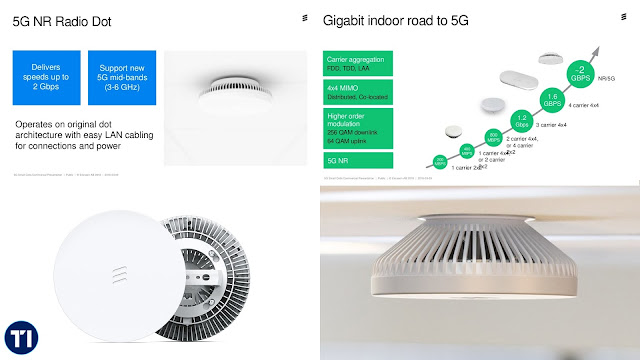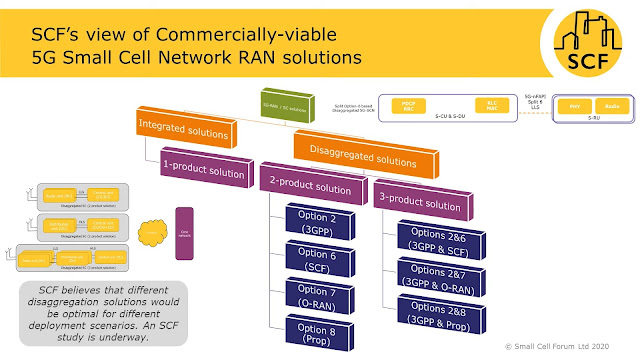We have been hearing about the promise of small cells for a very long time but looks like it may be about to become true. Quite a few analysts have mentioned about how small cells have an important role to play in both 5G and Private Networks.
Preliminary estimates suggest the small cell radio access network (RAN) market (excluding residential small cells) approached 1 to 1.5 M units in the first half of 2020, comprising a double-digit share of the overall RAN market. Aggregate small cell growth is tracking slightly below expectations, partly due to logistical challenges associated with the pandemic. At the same time, small cell RAN revenues improved more than 20% Q/Q in the second quarter, adding confidence the bulk of these transitory challenges are now in the past and are unlikely to impact the long-term demand for small cells.
The global growth outlook for small cells remains favorable, underpinning projections the technology will play an increasingly important role supporting the overall RAN network as operators and enterprises navigate new technologies, spectrum bands, and use cases. Cumulative global small cell RAN investments remain on track to approach $25 B over the next five years, advancing at a substantially faster pace than the macro RAN market. Helping to explain this output acceleration is broad-based acceleration across both the indoor and outdoor domains.
It should be mentioned that Small Cell definitions vary significantly from country to country and analyst to analyst.
Back in May, a report by Rethink Research had suggested that privately rolled-out enterprise networks will drive the small cell market to 26 million units by 2026.
The cells, according to the organisation’s RAN Research service, will be “increasingly diverse in form, ranging from compact versions of macro base stations to almost invisible systems embedded in electronic equipment.”
Sixty-eight per cent of these will be deployed in the enterprise and industrial space, enabled by emerging shared spectrum in the mid- and millimetre wave bands. Government, transport, healthcare, and hospitality will “lead the way” in terms of early adoption.
Again, back in May, Mobile Experts provided a new detailed report where they predicted that Small Cell equipment market will reach $5.5 Billion in 2025. Their press release stated:Mobile Experts published a report today that provides comprehensive analysis of trends in Small Cell development, including 3G, 4G, and 5G.
The report covers indoor and outdoor units in integrated, RRH, and distributed DRS. Residential, enterprise, and carrier segments are broken down in detail, and provide a forecast of 5G and Open RAN small cells deployed in sub-6GHz bands.
Mobile Experts reports that the enterprise segment will be a bright spot for Small Cells. Private LTE and Private 5G networks are on the rise, with new spectrum released recently in the USA, Germany, Japan, UK, and many other key countries considering a similar measure. While growth may be lackluster for a time due to COVID-19, growing interest in private LTE/5G wireless networking for industrial automation and other enterprise applications that require reliable, low-latency wireless links remains strong.
This report offers a comprehensive overall view of Small Cells, including information about technology and architectural evolution, spectrum trends, business model trends, and deployment by small cell customers. This report illustrates the market share positions for each type of small cell, highlighting the large tier-one vendors and also some surprising new emerging stars.
Going back to January, Kagan, a research group within S&P Global Market Intelligence, predicted that Small cell technology will be fundamental in mobile network coverage expansion over the next five years, as both wireless operators and enterprises leverage a combination of indoor and outdoor solutions to deliver 5G services as broadly as possible. Their announcement said:
While dense urban/metro and adjacent suburbs will be the primary focus, operators such as T-Mobile US Inc. that are asserting "nationwide" 5G coverage are also targeting rural areas for small cell deployments. According to new research from Kagan, global small cell shipments are expected to grow from 2.9 million units in 2019 to 3.7 million units by 2021, and 4.2 million units by 2024.
Total combined indoor and outdoor small cell revenue is expected to grow from $1.9 billion in 2019 to more than $2.2 billion for both 2021 and 2022, then decline slightly to just above $2 billion for 2023 and 2024. Following an established progression, we expect small cell revenues to decline even as unit shipments increase, as operators in all regions continue to expand their 5G network and service footprints and ASPs decline. The Asia Pacific market, led by aggressive 5G buildouts in China, South Korea and Japan, is seeing the highest volumes of small cell deployment. North America, driven by U.S. operators Verizon Wireless (VAW) LLC, AT&T Inc. and T-Mobile (which is using 600 MHz low-band spectrum for broader coverage per cell), is also a hotbed of small cell investment and network expansion efforts. Meanwhile, operators in Western Europe and India are likewise increasing their attention and capital spending on small cell densification. Operators in other regions, in addition to highlighting their 5G plans, are also implementing 4G LTE network enhancements, especially in markets such as Eastern Europe, the Middle East and Africa, or EMEA, and Latin America and Caribbean, or CALA, where current 4G coverage and capacity deficiencies must be remedied.
Despite the hype surrounding 5G, to be clear, 3G and 4G LTE deployments are expected to be strong through the next five years, and remain the dominant technology in terms of volume shipments until early 2022, when cumulative 5G small cell units will finally overtake 3G/4G LTE. Why? The fact remains that the ongoing small cell investment and deployment focus by operators worldwide, especially in the largest countries – China and India – is for 3G and 4G LTE network enhancement. And while outdoor coverage expansion is fundamental, indoor small cell network densification is also a top priority for all wireless operators, especially where outdoor coverage is already relatively saturated from a subscriber-per-cell standpoint.
Nevertheless, 5G technology is being deployed in earnest by operators in all global regions, although CALA — the smallest wireless and small cell market by far — will continue to lag significantly behind other regions. The initial 5G deployments, for example, in North America, have been with new radio, or NR frequencies, i.e., the 450 MHz to 6 GHz range, and the millimeter wave (mmWave) spectrum range, from 24 GHz to 52 GHz. The NR 5G small cells deployed by operators such as Verizon and AT&T in the U.S. include both standalone, or SA, and non-standalone, or NSA platforms, the latter leveraging existing 4G architectures and infrastructure to support both 5G services.
As small cell densification by wireless operators moves forward, integrated small cell platforms supporting both 5G and 4G radios will overtake the combined 5G NR NSA/SA small cell shipments in 2021, after a projected dead heat in 2020. The cost of integrated 5G/4G platforms may remain an impediment to the speed of investment for operators, but as volumes ramp up, prices will be driven down accordingly. Nevertheless, operator imperatives for 5G densification will spur accelerated growth of the integrated 5G/4G radios, with an inflection point in 2021 which continues with robust growth of this technology through 2024, as illustrated in the graph below.
"...by 2026, as many as 30% of the installed base of outdoor small cell networks, and 71% of indoor enterprise systems, are likely to be operated by new entrants to the cellular segment..." -- @SmallCell_Forum https://t.co/lyhe4OVkFk
— Ed Gubbins (@EGubbinsAnalyst) July 9, 2020
Interesting. People tend to think of factory or campus settings for private 4G/5G but 1/4 will be public/municipal deployments according to Small Cells Forum #IoT #IIoT #iotpl
— Matt Hatton (@MattyHatton) May 14, 2020
Quarter of private LTE and 5G networks will be managed by smart cities in 2025 https://t.co/AKWhtRE6eM
Each year, Small Cell Forum (SCF) publishes their own market status report, built around a detailed forecast of deployment of small cell networks in a range of scenarios. The core data source is a survey of about 100 operators & other service providers about their plans for the next six years. The report from this year states:
Our top-line global forecast for deployment and upgrade of small cells shows a healthy compound annual growth rate (CAGR) of 13% between 2019 and 2026, rising from a rate of 2.7 million in 2019 to 6.3 million by the end of the forecast period. That represents a cumulative total of 38.3 million small cells deployed (Figure 1).
While the highest CAGR (24%) will be seen in the urban environment, this is coming from a lower starting point – in 2019, over 80% of deployments were in indoor enterprise, industrial and campus settings. Enterprise small cells will account for the largest number of deployments throughout the period and by 2026 will account for 68% of the installed base, with a CAGR of 9%. Rural and remote small cells will be increasingly prominent as a result of the ubiquitous coverage requirements of some industrial and IoT applications, for instance in transportation or mining. The CAGR will be 19% in the period and by the end of 2026, 957 thousand rural and remote radio heads will have been installed.There are still considerable uncertainties in the market, so there s significant variation between best case and worst-case forecasts. Factors which affect this variation include the immaturity of 5G platforms and business models; immaturity in industrial and IoT business models; potential impact of the Covid-19 pandemic and recession; uncertain timescales for operators to adopt key enablers such as AI-enabled automation or cloud-native networks.
All of these factors may have a greater effect (positive or negative) than currently anticipated, with a knock-on impact on the forecast.
Related Posts:
- Telecoms Infrastructure Blog: 5G Small Cells Definition
- The 3G4G Blog: Macrocells, Small Cells & Hetnets Tutorial
- 3G4G: Small Cells (Femtocells, Home NodeB, Home eNodeB)









